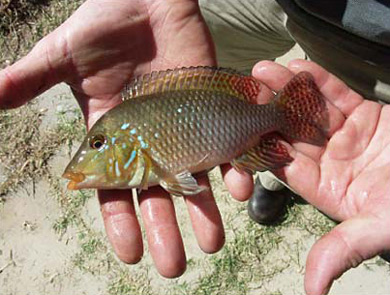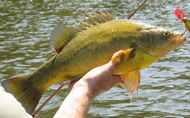Many Western Australian freshwater systems have been severely affected by pest species. The most widespread of the pest species in the southern half of the State is the mosquitofish (Gambusia holbrooki). Another 12 species of non-native pest finfish have been recorded in the southern half of the State. While in the north there have been fewer freshwater biodiversity surveys, therefore populations of pest species may exist which have not yet been reported.
Introduced species compete with native species for food, habitat and can potentially bring diseases. Some introduced species prey on the eggs, larvae and adults of native species, and there is also evidence suggesting that some species, such as the goldfish, cause environmental damage to aquatic habitats.
Identifying freshwater pest species
Have you seen or caught any of the species below? If so, please report it to us.
Silver Perch (Bidyanus bidyanus)

This species is native to the Murray-Darling system in eastern Australia. They can grow to a length of 300-400 mm. Large specimens become deep bodied and can have a large hump behind their head. They are a shimmery silver colour with fine scales, and the dorsal fin is spined.
If you want to translocate silver perch within WA, you will need to apply for Translocation Approval.
Goldfish (Carassius auratus)

This species is found in a range of sizes and colours, but in the wild are often bronze or olive-gold. Goldfish can grow to 4.5 kg and have a typical length of 200 - 300 mm. They have a single dorsal fin and are deep bodied. They generally resemble a larger, more bulbous version of the typical orange goldfish found in many aquarium tanks.
Common Carp (Cyprinus carpio)

This species is found in a range of sizes and colours, but in the wild are often bronze or olive-gold. Carp can grow to 40 kg and reach a length of 1.2 metres, although they are most commonly found between 300 - 600 mm. Common carp have a single dorsal fin and have a pair of ‘whiskers’ under their chins, used to feel for prey in muddy water.
Mosquitofish (Gambusia holbrooki)

Small fish, up to 60 mm long, they are olive-brown to bronze or silvery, with a single dorsal fin and the males have a long anal fin. They are often seen in small schools and may be mistaken for swordtails or guppies. Mosquitofish will only eat mosquito larvae if nothing else is available. However, native fish whose eggs mosquitofish often consume, will usually eat far more mosquito larvae. There is also evidence that mosquitofish bite and damage the fins of other fish.
Pearl cichlid (Geophagus brasiliensis)

A colourful fish with pearly spots overlaying a green-grey body and reddish fins. Cichlid can live up to 15 years and males can reach a length of 300 mm. Note that colours can change with mood or during mating season, and vertical bands have also been seen on some specimens.
Golden Perch (Macquaria ambigua)

Golden perch have a spiney dorsal fin, in contrast to its other fins, which are rounded. Colouring ranges from a silvery light gold, to deep gold, and sometimes even bronze. Suited to both turbid and clearer water bodies, golden perch grow larger in man-made water bodies (up to 15 kg) and up to 2 kg in rivers. They are mostly around 400 - 500 mm in length and have a yellow belly. They can also have a concave forehead and protruding lower jaw.
Redfin Perch (Perca fluviatilis)

Redfin perch have distinctive red fins, spiny dorsal fins and many have dark vertical banding. They have two distinct dorsal fins, the first having 12 - 17 spines, and the second one is rounded. They are commonly found up to 450 mm. Redfin perch have no bag or size limits.
One-spot livebearer; speckled livebearer (Phalloceros caudimaculatus)

This species body color can vary in environmental conditions, but is generally silver with a yellowish shine. The males of the species are speckled with irregular black spots and blotches. Females are less spotted than the males and their bodies are much larger. A small and stocky fish with large eyes, it has a size range of 35 - 55 mm.
photo: Mark Maddern
Rosy Barb (Puntius conchonius)

In this species, both sexes are silver, but during mating season the males exhibit a deep red colour, and the slightly larger females turn a more luminous silver. Females can grow to a length of 140 mm. They are deep bodied and have relatively small heads compared to their bodies. They often exhibit a dark spot on both sides of their body near the base of the tail.
Swordtails (Xiphophorus helleri)

Swordtails can reach 120 mm although adults are usually around 80 mm in length. Often orange coloured in aquaria, they become bronze or olive in the wild. Due to their shape they are sometimes confused with guppies and gambusia. However, the lower part of the tails of male swordtails are distinctively long – hence the name.
Convict Cichlid; zebra cichlid (Amatitlania nigrofasciata)

The wild type of this species has up to 8 - 9 vertical black stripes with a blue/grey body colour. Unusual for fish, the female is the more brightly coloured sex, with pink to orange colouring around the abdominal area, and fins more angled than the male. Relatively small compared to other cichlids, the average length of mature males in the wild ranges is 60–66 mm, while breeding–sized females range from 42 – 55 mm.
Tilapia (Oreochromis, Sarotherodon, and Tilapia)

Although there are many species of tilapia, only the Mozambique mouthbrooder is established in the wild in WA. This fish can grow to 400 mm long and 2 kg in weight, but most are smaller. Dark in colour, they have a single long dorsal fin and large anal fin. They have prominent lips and are often found in small schools.
Guppies (Poecilia reticulate)

Males rarely exceed 30 mm and females 60 mm. Usually bronze or olive, guppies have a broad body and a slender tail. In the wild, the males lose their ornamental tails and have a resemblance to gambusia and swordtails rather than native fish.
Yabbies (Cherax albidus and Cherax destructor)

Yabbies have only four ridges on the back of their heads, whereas marron and gilgies have five. Yabbies have fine hairs on the inner edge of their clawed limbs. They are also usually a paler colour than native crustaceans. Our  Identifying Crayfish fact sheet provides more information. While they pose a widespread threat to native species of freshwater crayfish, they can be legally farmed in a dam or lake on private land to the north and east of the Albany Highway.
Identifying Crayfish fact sheet provides more information. While they pose a widespread threat to native species of freshwater crayfish, they can be legally farmed in a dam or lake on private land to the north and east of the Albany Highway.
If you want to import yabbies into WA, you will need to apply for translocation approval.
If you catch yabbies, you can eat or freeze them, but don’t use them for live bait and don't release them into rivers, lakes or dams.
Redclaw (Cherax quadricarinatus)

Redclaw crayfish are a relatively large species of freshwater crayfish growing up to 500 g, and an average size of 200 mm. Their shell ranges from green to deep blue in colour, and males have a bright red marking on the outer margin of their pincers. They are found in freshwater streams, lakes and billabongs. Naturally distributed in NT and QLD, they have been sighted in far north WA, due to human introduction. They can out-compete native marron.
Managing pests
The control of freshwater pest species in WA is a complex issue. The diverse range of aquatic habitats across the State makes it impossible to apply a single management strategy that suits all habitats. Measures also need to take into account both the control of already established pest fish such as goldfish and mosquitofish, and minimise the risks of new species becoming established in the wild.
As most introduced species are spread primarily by people either deliberately or accidentally, we are working on raising levels of awareness of the issue. We also rely on the cooperation of all members of the community in helping to minimise this threat.
Where there is a need to control pests, we focus on an acceptable and practical level of managing the impacts of the pest as opposed to eradicating it entirely. With the current technology and expertise available, eradication is only feasible under a very limited set of circumstances (eg. if pest fish are found only in an enclosed water body).
What you can do
You can play an important role in preventing the release of aquatic pests and reporting any you might see or catch in the aquatic environment.